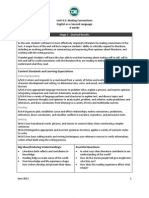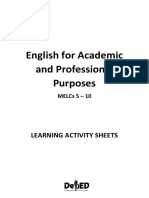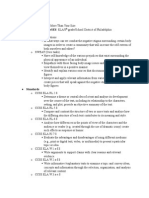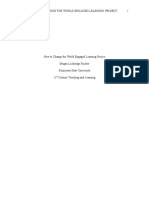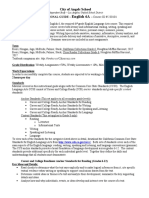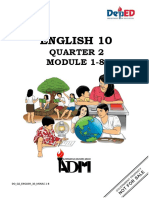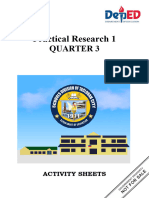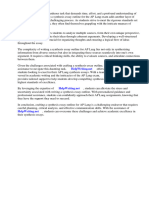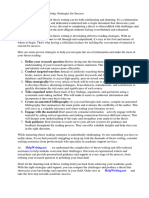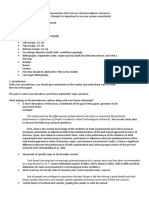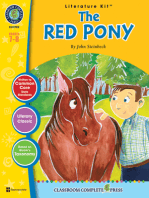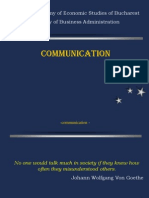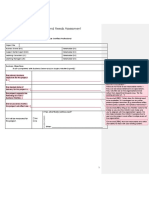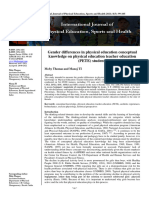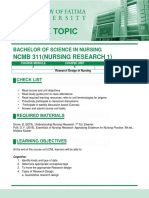EAPP LAS Week-2
EAPP LAS Week-2
Uploaded by
Affleck VrixCopyright:
Available Formats
EAPP LAS Week-2
EAPP LAS Week-2
Uploaded by
Affleck VrixOriginal Title
Copyright
Available Formats
Share this document
Did you find this document useful?
Is this content inappropriate?
Copyright:
Available Formats
EAPP LAS Week-2
EAPP LAS Week-2
Uploaded by
Affleck VrixCopyright:
Available Formats
Republic of the Philippines
Department of Education
REGION VIII
TACLOBAN CITY
LEYTE NATIONAL HIGH SCHOOL SENIOR HIGH SCHOOL
ENGLISH FOR ACADEMIC AND PROFESSIONAL PURPOSES (EAPP)
Learning Activity Sheets (LAS)
Name of Student: ______________________________________________________
Year Level: ____________________
Section: ________________________
Date: Week 2: Sept. 5 – 8, 2022
FUNDAMENTALS OF READING ACADEMIC TEXTS
(CRITICAL READING STRATEGIES)
Background Information for Learners/ Panimula (Susing Konsepto)
CRITICAL READING STRATEGIES
• Academic reading requires focus and understanding.
• Interact with the text by questioning its assumptions, responding to its arguments, and connecting it to real-life
experiences and applications.
• Critical or reflective reading helps identify the key arguments presented by the author and analyze concepts
presented in the text.
• Practice reading strategies to be employed during each stage of reading.
o BEFORE READING
Determine the type of academic text to be read
Establish purpose for reading
Identify author’s purpose for writing
Predict or infer the main idea or argument of the text based on its title.
Identify your attitude towards the author and the text
State what you already know and what you want to learn about the topic.
Determine target audience
Check publication date for relevance. (at most 5 years earlier than current year)
Check reference list
Use a concept map or a graphic organizer to note existing ideas and knowledge on the topic.
o DURING READING
Annotate important parts of the text. This can help determine essential ideas or information,
main ideas or arguments, and new information or ideas.
Use dialectic journal if the reading material is not personally owned.
o AFTER READING
Reflect on what you learned
React on some parts of the text through writing Discuss some parts with teacher or
classmate.
Link the main idea of the text to what you already know.
Learning Competency with Code/ Kasanayang Pampagkatuto at Koda
Differentiates language used in academic texts from various disciplines (CS_EN11/12A-EAPP-Ia-c-2)
ACTIVITY 1:
Read the following excerpt from the conclusion of Dhiraj, et.al’s study. To better understand the text, make a Dialectic
Journal about it. You may use another sheet of paper for your answer.
Given that the influence of mobile technologies on tweeting patterns has been understudied, we sought to
bridge this gap by examining whether tweets from mobile and web-based sources differ significantly in their
linguistic styles. We studied 6 weeks of Twitter spritzer stream data, containing 235 million tweets. We focused
on the analysis of tweets by source – specifically, mobile versus web-based sources by time of day. This
involved evaluating several categories or subsets in which mobile sources may be similar to or different from
web sources. We used word lists from social psychology to test for levels of egocentricity, gender style,
emotional content, and agency in both mobile and web tweets.
Ultimately, we found that mobile tweets are not only more egocentric in language than any other group, but that
the ratio of egocentric to non-egocentric tweets is consistently greater for mobile tweets than from nonmobile
sources. We did not find that mobile tweets were particularly gendered. Regardless of platform, tweets tended to
employ words traditionally associated as masculine. We did find that negative language is used more frequently
by mobile users at any point in time, a finding that would benefit from further research. The ratio of negative to
positive unigrams was also found to be consistently greater for mobile tweets than web tweets. Lastly, we did not
find that mobile-based tweets are more agentic than web-based tweets. Rather, both platforms tended to employ
language that was associated with communal behaviors.
Source: Do We Tweet Differently From Our Mobile Devices? A Study of Language Differences on Mobile and
Web-based Twitter Platform http://onlinelibrary.wiley.com/doi/10.1111/jcom.12176/pdf
ACTIVITY 2:
1. Think of a specific topic which personally interests you. Find and read three academic texts related to this specific
topic using the links: https://scholar.google.com.ph/schhp?hl=en&as_sdt=0,5 or http://www.palgrave-
journals.com/pal/information/free_articles.html
2. Using 500-750 words, write a synthesis of the texts. Use the questions below as your guide in writing.
A. Text Information
a. What are the main ideas of the text?
b. What new information of ideas did you find in each?
B. Synthesis
a. How are the three texts related to one another? How do they contribute to the field?
b. What have you learned from the text? How can these new ideas be helpful in:
• Your life choices or decisions?
• The way you think about yourself, others, or society?
• The way you shape yourself into what you want to be?
3. Follow the format and mechanics presented below:
• Use the following paper format: o Short bond paper (8”x11”) o
Times New Roman font; size 12 pts o 1.5 spacing
o 1-inch margin on all sides
Paginate at the right bottom page.
• Use a number format; label the first part as Text Information, and
the second part as Synthesis Report. Separate the pages for these
parts.
• Do not exceed five pages.
• Provide a list of references at the last part of the report (APA style)
Use the template below for your heading.
Name: Year level:
Instructor: Date:
Name of Activity: SYNTHESIS REPORT Word Count:
Rubric for scoring/Rubrik sa Pagpupuntos (if necessary)
Reflection / Pangwakas:
References for learners/Mga Sanggunian
http://onlinelibrary.wiley.com/doi/10.1111/jcom.12176/pdf https://scholar.google.com.ph/schhp?
hl=en&as_sdt=0,5
http://www.palgrave-journals.com/pal/information/free_articles.html
https://mseffie.com/assignments/synthesis/Synthesis%20Essay%20Rubric%204.pdf
Barrot, J. & Sipacio, P. (2016). Communicate today. English for academic and professional purposes for senior high
school. Quezon City: C&E Publishing, Inc.
Prepared by: Checked by:
JEAROEVEM MARIE L. PACIENCIA JULIANA C. ARPON
Subject Teacher MT-I, Group Head Designate, GA
You might also like
- Practical Research 2: Quarter 1 - Module 8: Review of Related LiteratureDocument20 pagesPractical Research 2: Quarter 1 - Module 8: Review of Related Literatureurhen60% (5)
- Bridging The GapDocument7 pagesBridging The GapAmin Mofreh100% (1)
- Practical Research 1: Quarter 3 - Module 13: Literature ReviewDocument26 pagesPractical Research 1: Quarter 3 - Module 13: Literature ReviewRemar Jhon Paine100% (2)
- Analysis of A School-Wide Literacy ProgramDocument12 pagesAnalysis of A School-Wide Literacy ProgramAnonymous 2LlckArNo ratings yet
- Unit Plan Sample AssignmentDocument11 pagesUnit Plan Sample Assignmentchh2373No ratings yet
- Reviewer Assessment of Learning 1ST Sem 3RD Yr MidtermDocument11 pagesReviewer Assessment of Learning 1ST Sem 3RD Yr Midtermlorday83% (12)
- Visually Impaired PresentationDocument11 pagesVisually Impaired PresentationRajesh SoniNo ratings yet
- Quantum Physics and Law of AttractionDocument3 pagesQuantum Physics and Law of Attractionsiddharth_43293100% (2)
- Lesson 2 Academic Reading StrategiesDocument10 pagesLesson 2 Academic Reading StrategiesMA. luisa ECHANONo ratings yet
- App Review1Document9 pagesApp Review1api-419246945No ratings yet
- App AssignmentDocument9 pagesApp Assignmentapi-261396852No ratings yet
- LessonplanassignmentDocument8 pagesLessonplanassignmentapi-324050926No ratings yet
- Aspects of Writing Cluster 11Document7 pagesAspects of Writing Cluster 11S TANCREDNo ratings yet
- U2L4 SN - Writing A CritiqueDocument5 pagesU2L4 SN - Writing A CritiqueIvanNo ratings yet
- Bibliography English Language CourseworkDocument5 pagesBibliography English Language Courseworkpanel1bumyj3100% (2)
- Literature ReviewDocument27 pagesLiterature ReviewElsa Quiros TerreNo ratings yet
- Itec 7430 Lesson Plan and ScreencastDocument10 pagesItec 7430 Lesson Plan and Screencastapi-534721555No ratings yet
- Eng7 q4 w1 Studentsversion v2Document10 pagesEng7 q4 w1 Studentsversion v2VictorNo ratings yet
- Unit 9.5: Making Connections English As A Second Language 6 WeeksDocument6 pagesUnit 9.5: Making Connections English As A Second Language 6 WeeksMarilu Velazquez MartinezNo ratings yet
- 3rd Quarter EAPP MELCs 5 10Document79 pages3rd Quarter EAPP MELCs 5 10Rica ParillaNo ratings yet
- Q3 G12 Reading and Writing Skills GradeDocument33 pagesQ3 G12 Reading and Writing Skills GradeIrma Rose PereyraNo ratings yet
- Unit Title: You Are More Than Your Size Content area/grade/SES: ELA/8 ObjectivesDocument4 pagesUnit Title: You Are More Than Your Size Content area/grade/SES: ELA/8 Objectivesapi-302680966No ratings yet
- PDR 1Document4 pagesPDR 1api-383400784No ratings yet
- Wlas Eapp Week 2Document26 pagesWlas Eapp Week 2Tisoy Calubag CarmonaNo ratings yet
- Final Engaged Learning ProjectDocument8 pagesFinal Engaged Learning Projectapi-321269218No ratings yet
- IG English 6A CA CollectionsDocument12 pagesIG English 6A CA CollectionsMelania StepanianNo ratings yet
- Q2 - English 10Document39 pagesQ2 - English 10Ma'am Jone100% (1)
- E-Learning Review of LiteratureDocument7 pagesE-Learning Review of Literatureafmzvadyiaedla100% (1)
- Las - PR1 Q3.W8Document11 pagesLas - PR1 Q3.W8Lotis RompalNo ratings yet
- Baikd Part eDocument5 pagesBaikd Part eapi-317153463No ratings yet
- Literature Review On English As A Second LanguageDocument5 pagesLiterature Review On English As A Second Languaged0vidihujam3No ratings yet
- Iii 3-5Document13 pagesIii 3-5Juliebeth LucianoNo ratings yet
- App ReviewDocument9 pagesApp Reviewapi-288784313No ratings yet
- Class-Date: Unit: Lesson TitleDocument3 pagesClass-Date: Unit: Lesson Titleapi-311804577No ratings yet
- WLAS EAPP Week 2 - 1Document26 pagesWLAS EAPP Week 2 - 1Romeo Espinosa Carmona JrNo ratings yet
- Connecting Your Goals To LPC AssignmentDocument6 pagesConnecting Your Goals To LPC AssignmentJamison FawkesNo ratings yet
- RWSModule 6Document8 pagesRWSModule 6LiezelNo ratings yet
- Practicalresearch1 q3 Mod12 Apacitationstyle FinalDocument24 pagesPracticalresearch1 q3 Mod12 Apacitationstyle FinalJenny Gusilatar64% (11)
- EDITED-Eng7 q4 Mod1 Academic-Writing v1 Forprinting-1Document11 pagesEDITED-Eng7 q4 Mod1 Academic-Writing v1 Forprinting-1Anthony J CastroNo ratings yet
- Literacy Portfolio Assignment 2Document2 pagesLiteracy Portfolio Assignment 2api-449058132No ratings yet
- Research Paper Sample Body ParagraphDocument5 pagesResearch Paper Sample Body Paragraphwroworplg100% (1)
- Rhet 1311 Syllabus 1Document9 pagesRhet 1311 Syllabus 1api-652050307No ratings yet
- Practical Research 2: Quarter 1 - Module 8: Review of Related LiteratureDocument20 pagesPractical Research 2: Quarter 1 - Module 8: Review of Related LiteratureDivina Grace Rodriguez - LibreaNo ratings yet
- Synthesis Essay Outline AP LangDocument4 pagesSynthesis Essay Outline AP Langafknoaabc100% (3)
- Thesis Reading Strategies PDFDocument8 pagesThesis Reading Strategies PDFlorigilbertgilbert100% (2)
- DAILY - LESSON - PLAN-coherent FinalDocument8 pagesDAILY - LESSON - PLAN-coherent FinalMichael WilliamsNo ratings yet
- Strademarsala Ebpfinal Lai474Document10 pagesStrademarsala Ebpfinal Lai474api-451567788No ratings yet
- Level 3 - Research Essay OverviewDocument3 pagesLevel 3 - Research Essay OverviewJohnny LiNo ratings yet
- Outline of Case Study or Survey-Based SkripsiDocument11 pagesOutline of Case Study or Survey-Based SkripsiParlindungan PardedeNo ratings yet
- Lesson Plan-WikiDocument4 pagesLesson Plan-Wikiapi-361174753No ratings yet
- Unit - Unit III - The Lens of History - 20201219165635Document10 pagesUnit - Unit III - The Lens of History - 20201219165635Ashley PérezNo ratings yet
- SLM Eapp12q3m2Document16 pagesSLM Eapp12q3m2Nena HoyohoyNo ratings yet
- Critical AnnotationDocument11 pagesCritical Annotationh680z3gvNo ratings yet
- Siop SparknotesDocument8 pagesSiop Sparknotesapi-244606258No ratings yet
- Thinglink Lesson PlanDocument7 pagesThinglink Lesson Planapi-247714219No ratings yet
- Linear and Non-Linear Text LPDocument4 pagesLinear and Non-Linear Text LPMarc Quia100% (1)
- Cooper Ms Syllabus 2016Document3 pagesCooper Ms Syllabus 2016api-325715949No ratings yet
- Reading U3w5 Lesson PlanDocument6 pagesReading U3w5 Lesson Planapi-239626791No ratings yet
- How To Write A Term PaperDocument4 pagesHow To Write A Term PaperAlt COCNo ratings yet
- EAPP For GClassroom UploadingDocument55 pagesEAPP For GClassroom Uploadingaljon nueva espanaNo ratings yet
- 3 I's Wk.3-5 Related LiteratureDocument40 pages3 I's Wk.3-5 Related LiteratureLen Ramon CMNo ratings yet
- Chapter 14 (1000 Word Essay)Document2 pagesChapter 14 (1000 Word Essay)Peter Thomas LimNo ratings yet
- Simple SentenceDocument4 pagesSimple SentencekjavNo ratings yet
- Unidad 1.4 AdjectivesDocument3 pagesUnidad 1.4 AdjectivesFrancisco Antonio BahamondesNo ratings yet
- Sow English Year 2 2021 (SKTS)Document12 pagesSow English Year 2 2021 (SKTS)Onnie RahmanNo ratings yet
- All Chapters PDFDocument126 pagesAll Chapters PDFJason CowellNo ratings yet
- Nanhaya Nhs Math Pi Day, Letter, Matrix and Accomplishment ReportDocument9 pagesNanhaya Nhs Math Pi Day, Letter, Matrix and Accomplishment Reportimelda dolienteNo ratings yet
- AI Project ListDocument6 pagesAI Project ListAnay BiswasNo ratings yet
- Why There Is No God PDFDocument34 pagesWhy There Is No God PDFvishnu09980% (5)
- Bozdaglioglu - Constructivism and Identity FormationDocument24 pagesBozdaglioglu - Constructivism and Identity FormationCipriano Mera100% (1)
- Lesson Plan 4Document4 pagesLesson Plan 4api-339167965No ratings yet
- English Exercises - Comparisons With As... As..Document2 pagesEnglish Exercises - Comparisons With As... As..quiroz_dcNo ratings yet
- Scientific Report Components.Document15 pagesScientific Report Components.Alison LucantonioNo ratings yet
- Analysis of Data in Python - ALXDocument3 pagesAnalysis of Data in Python - ALXMos DetNo ratings yet
- Internship Opportunities PDFDocument2 pagesInternship Opportunities PDFMD MoizNo ratings yet
- 2022 McKinsey Taipei Scholar ProgramDocument5 pages2022 McKinsey Taipei Scholar Program巫信霈No ratings yet
- The Linguistic Profile of Down's Syndrome SubjectsDocument22 pagesThe Linguistic Profile of Down's Syndrome SubjectsLee Wai KeatNo ratings yet
- 11 - Lecture - Communication and Its Importance For HRMDocument26 pages11 - Lecture - Communication and Its Importance For HRMRareş SpiracheNo ratings yet
- Sample Intake FormDocument2 pagesSample Intake FormRenato Barrientos La RosaNo ratings yet
- 8-4-97-757-Moby and ManojDocument7 pages8-4-97-757-Moby and ManojManoj TI , KAUNo ratings yet
- Concept Paper in ALM221Document10 pagesConcept Paper in ALM221Giselle Sadural CariñoNo ratings yet
- Procedding APPBIPA Thailand Conference 23Document10 pagesProcedding APPBIPA Thailand Conference 23Humas APPBIPA ThailandNo ratings yet
- Fitness Lesson Plan - GoodDocument3 pagesFitness Lesson Plan - Goodapi-379073268No ratings yet
- The Action Research of Classroom ManagementDocument4 pagesThe Action Research of Classroom ManagementCharline Radislao100% (2)
- Instructional-DesignDocument14 pagesInstructional-DesignTijana BrzićNo ratings yet
- Activity 7: Focusing On Important Rizalian Traits and VirtuesDocument11 pagesActivity 7: Focusing On Important Rizalian Traits and VirtuesWendy GarciaNo ratings yet
- First Course: What Is Literature?: Literature Courses of Sidi Bel Abbes LMD First YearDocument4 pagesFirst Course: What Is Literature?: Literature Courses of Sidi Bel Abbes LMD First YearbelbachirNo ratings yet
- COURSE TOPIC-Nures 1 CM2-CU6-3Document8 pagesCOURSE TOPIC-Nures 1 CM2-CU6-3Jordz PlaciNo ratings yet


















